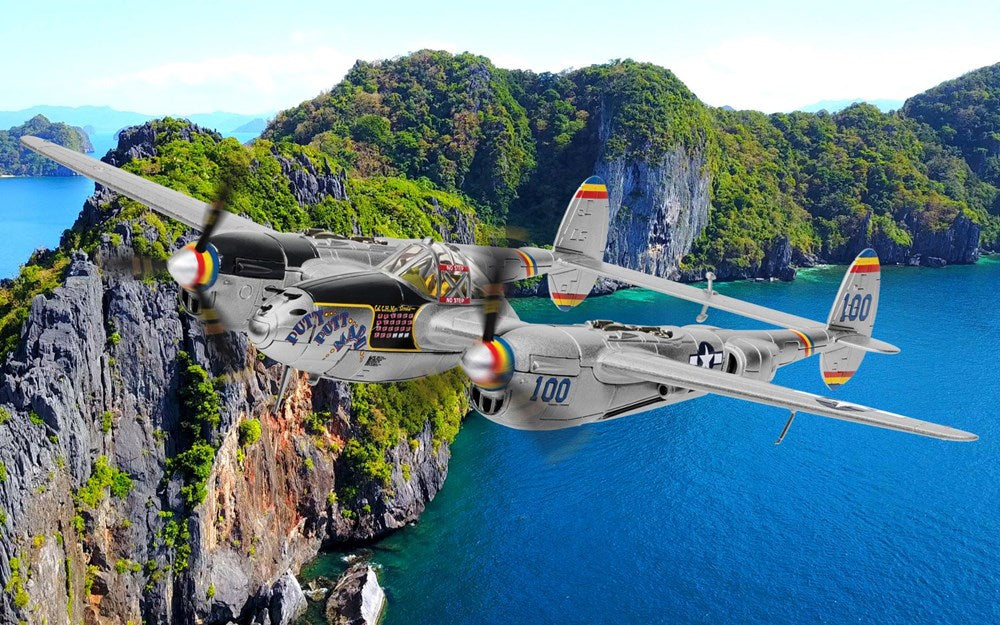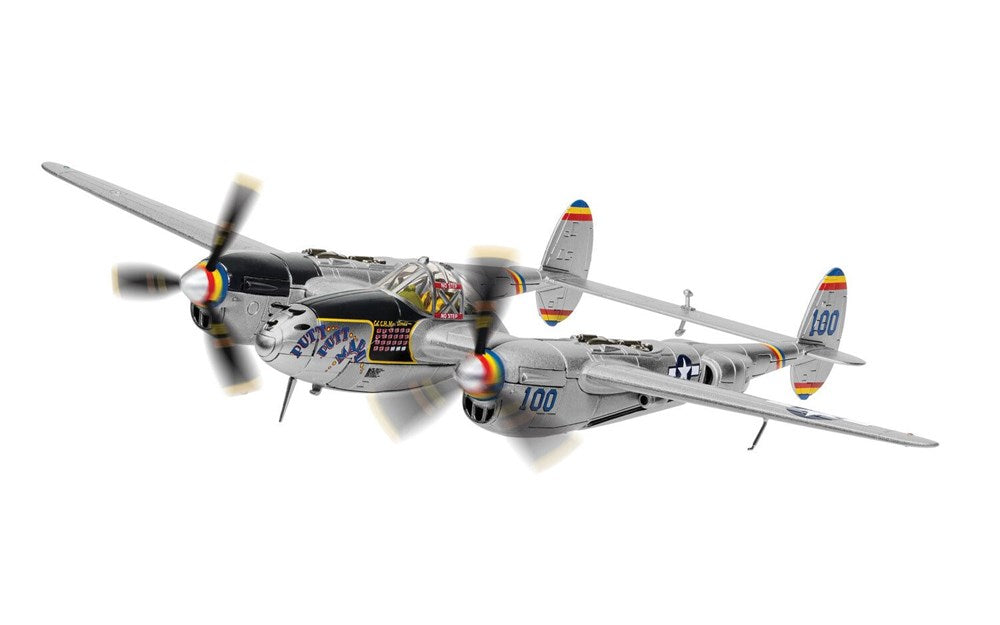
Corgi AA36617 1:72 Lockheed P-38L Lightning, 'Putt Putt Maru', 1945
$5 COURIER DELIVERY within NZ for all orders over $99 NZD!
Product Info
Lockheed P-38L Lightning, 'Putt Putt Maru', Col. Charles McDonald, 475th FG USAF, Philippines, 1945.
Having seen the introduction of advanced monoplane fighter designs in both the German and Japanese air forces, America was only too aware that their own Air Force was in need of upgrade as a matter of urgency. To this end, an official requirement was issued in February 1937 for the production of a new pursuit fighter, an aircraft which would have to possess performance which had never previously been seen, not only on an American aircraft, but anywhere else in the world. The Lockheed Aircraft Company were one of six companies determined to satisfy this demanding requirement and entrusted the design of this radical new aircraft to talented designer Clarence 'Kelly' Johnson, who was basically given a free rein during its development. Almost immediately, he determined that a single engined aircraft could not satisfy these demanding specifications and started work on a twin engined design, one which featured twin booms to house the engines and superchargers, with a centrally positioned nacelle for the cockpit and the fighter's heavy armament.
The new aircraft looked incredible and was a radical departure from any fighter aircraft design that had gone before it, with Lockheed being awarded a contract to produce a prototype example. The XP38 was a thing of beauty and after just a short 38 minute maiden flight, everyone at Lockheed knew they had a winner on their hands. In fact, officials were so impressed with the aircraft's performance that they immediately decided to make an attempt on the US Transcontinental speed record to highlight its potential, an attempt which saw the XP38 shatter the existing record by an impressive 23 minutes. Unfortunately, it appears that officials at the destination airport were not expecting the arrival of the strange new fighter and kept it holding so long that it actually ran out of fuel and had to make an emergency landing on a local golf course. Nevertheless, the aircraft had shown its potential and the US Army Air Force ordered sixty-six aircraft and America had their first 400 mph fighter.
The introduction of the P-38 Lightning was not without its problems, however, this was not surprising bearing in mind its performance and configuration were so radically different to anything which had gone before it. Almost constant development would see the Lightning develop into a devastatingly effective high altitude interceptor and with engines which both drove outwardly rotating propellors, also eventually proved to be an incredibly stable aircraft. Possessing impressive range and firepower, the Lightning would eventually be used to avenge the Pearl Harbor attack, when sixteen P-38s of the 339th Fighter Squadron intercepted a bomber carrying Admiral Isoroku Yamamoto, the mastermind of that infamous raid, and shot it down. The P-38 Lightning would go on to serve with distinction in both the Pacific and European theatres, one of the most capable and distinctive aircraft of the Second World War.
For US fighter pilot Charles Henry 'Mac' MacDonald, the Japanese attack at Pearl Harbor on 7th December 1941 left him with a determination to do his duty in ensuring this disastrous day for America would only result in their eventual victory. Joining the USAAF and gaining his wings in May 1939, he would first be assigned to the 55th Pursuit Group and then on to the 18th Pursuit Group at Wheeler Field, Hawaii in early 1941 and was still there at the time of the Japanese surprize attack, arguably the darkest day in American military history. His continued service would see him gaining ever more responsibility and new postings, first back home in the US to train new pilots, then on to the savage fighting of the Pacific War. By October 1943, he had attained the rank of Major and was posted as the Executive Officer of the 475th Fighter Group's 'Satan's Angels', flying P-38 Lightnings out of Dobodura, New Guinea, where his reputation as a fighter ace and effective leader of men would soon be forged. Often asking his men to fly dangerous long range missions in their Lightnings over vast expanses of ocean, MacDonald, would often be the first aircraft into the air, leading from the from and inspiring his pilots to make their mark on the war.
Eventually attaining the rank of Colonel, MacDonald became the Commanding Officer of the 475th Fighter Group and during this time, would welcome the arrival of a rather famous civilian advisor to the unit, long range aviator and US national hero Charles Lindbergh, who was cleared to fly with the unit. During his time in the Pacific, Lindbergh would help the 475th unlock the awesome potential of the P-38, using his knowledge of long range engine management to alter the power and fuel settings of their aircraft, modifications which extended the range of the Lightning by an incredible 100%. Now, 'Colonel Mac' and the pilots of the 475th could provide fighter cover for bombers attacking the Japanese oil refineries at Balikpapan in Borneo, with flight times of between twelve and fourteen hours needing to be flown. This raid was pivotal in turning the tide of the Pacific War and preparing American forces for the final push towards the Japanese home islands.
Colonel 'Mac' Macdonald would end the war with 27 aerial victories, with several others either damaged or probably destroyed, making him the third most successful fighter ace in the Pacific Theatre. All victories were scored using the Lockheed P-38 Lightning and whilst he would use several different machines, they were all named 'PUTT... PUTT... MARU'. It is not known for sure what this name refers to, but it is thought that it could be a reference to the Japanese supply barges the unit were often sent to destroy, vessels which were referred to as Marus, with their rather agricultural engines making a putt putt chugging sound. Whatever the case, if they were in the sights of a 475th Fighter Group P-38 Lightning, they were on borrowed time.
What's Inside
1 x Aircraft, 1x StandTech Specs
- Item Length - Without Packaging (cm)
- 15.1
- Item Height - Without Packaging (cm)
- 5.2
- Item Width - Without Packaging (cm)
- 21.8
- Item Scale
- 1:72 Scale
- License line
- Produced under license. Boeing, their distinctive logos, product markings and trade dress are trademarks of The Boeing Company
- Finish
- Painted
- Colour
- Multi
- Wingspan (mm)
- 218
- Detailed Crew Figures
- Yes
- Optional Undercarriage Down
- Yes
- Rotatable Propeller(s)/Rotor(s)
- Yes

